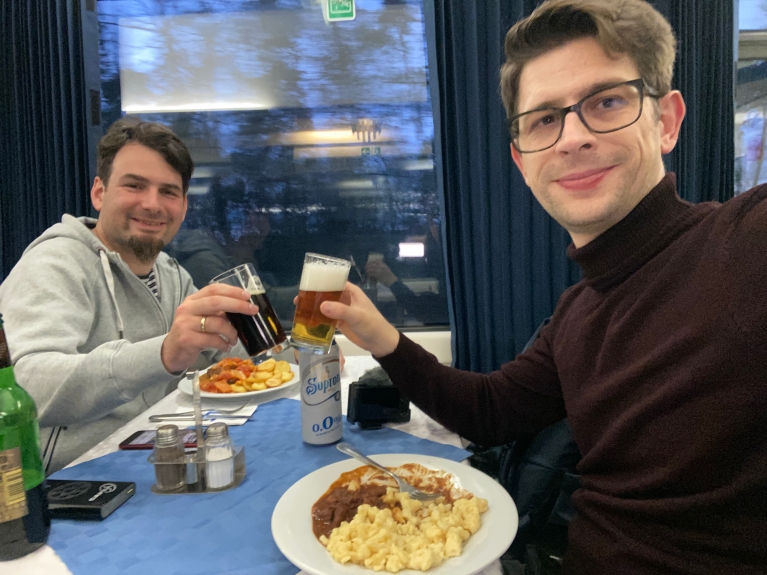
How many train dining cars can you visit in 24 hours? Two friends tried to find out
6 February 2024
Many train travellers appreciate the feeling of relaxing in a dining car, watching Europe’s countryside flash by as they enjoy a tasty meal.
But few have demonstrated their passion for dining cars as clearly as Lennart, an Interrailer from Germany.
Late last year, Lennart and his friend, Félix, embarked on a unique mission: to try as many dining cars as possible in the span of one day.

“The idea of the trip is to show the beauty and diversity of European dining cars,” Lennart explained. “I ended up planning a trip that includes as many dining cars of different railways as possible within 24 hours.”
Along the way, the two travellers covered five countries, dined on regional specialities such as schnitzel, goulash and currywurst, and discovered what may be the best dining car breakfast in Europe’s train network.
They documented their journey in a video currently available to watch on Félix’s YouTube channel.
“The rules are simple: when you visit the first dining car, we get a 24-hour countdown,” Félix says in the video. “Within this time, we shall snack or dine in as many different dedicated, attended dining cars as possible.”
Lennart is no stranger to dining cars aboard European rail lines – and their benefits for travellers of all ages.
“Often when I travel for business or leisure, I eat onboard trains,” Lennart said. “I have always appreciated the variation, and that's how I came up with [the idea for] the dining car trip.”
“With my two small children I find it is one of the most win-win situations while travelling; my children get a bit of variation on the trip and appreciate the ‘special’ food, we have a relaxed time, have less food to carry and lose absolutely no time while we eat,” he continued.
To pull off the trip, Lennart used two travel days from a 4-day Interrail Pass he had purchased for a trip to Sicily two weeks prior and spent time considering the most efficient way to ride as many trains as possible in a 24-hour window.
“When I realised that schedules fit together quite well if you start in Southern Germany or Switzerland in the afternoon and spend the next day around Vienna, I decided to take that route,” he explained.
“I loved that all of the trains we used were without mandatory reservations, so we could just board the train, save the trip on our digital passes and head straight to the dining car.”

Lennart and Félix began their dining car adventure in the southern German city of Freiburg at 5 p.m. on a Friday, where they boarded the Italian ECE en route from Milan to Frankfurt. Four train rides (and dining car experiences) later, they arrived in Munich at 11 p.m.
After spending midnight in Munich – taking in some city views before the next leg of the trip – they boarded an overnight train to Vienna, which served as the duo’s “dining car hub” during their adventure. After an early morning stop in the Vienna ÖBB lounge, the pair hopped on an EC to Wiener Neustadt, an Austrian city south of Vienna, and sampled the Slovenian offerings in the dining car.
On this train, the duo experienced one of their favourite moments of the trip. “We ordered some omelettes and coffee for breakfast after our short night [journey] on the Intercity,” Lennart said. “The attendant came back ten minutes later with two perfect, freshly cooked omelettes, just before the Alps loomed into view.”
“A wonderful moment and possibly the best dining car breakfast in Europe,” he said.
Once reaching Wiener Neustadt, they doubled back past Vienna, crossing Austria into the Czech Republic from their seats in an RJ dining car. By 11 a.m. Lennart and Félix were on their way to Bratislava, enjoying the offerings of a Czech dining car before heading back to Vienna again.
“I loved the ‘dining car triangle,’ with trains travelling between the four capitals: Prague, Vienna, Bratislava and Budapest,” Lennart said. “We got to experience some of the best of Central European cuisine, including Hungarian goulash, Czech knedlík, Polish dumplings and Slovak chocolate pancakes.”
The views out the window of the dining car were also a delight, Lennart said. “I was surprised by the beauty of the landscape in the Vienna-Bratislava-Breclav area. Flat marshlands, mountains in the distance and numerous views of the river Danube.”
Lennart sampled one of his favourite meals of the trip during an afternoon journey from Vienna back to Breclav, a town in the Czech Republic, this time aboard a train with a Polish dining car.
“The freshly cooked Polish Kotlet Schabowy pork schnitzel was definitely one of the highlights, closely followed by pork cheek goulash with knedlík from the Czech dining car and traditional beef goulash from the Hungarian dining car.”
Those who don’t eat meat are well catered to as well, Lennart said. His favourite vegetarian meal of the trip? “A wonderfully flavoured vegan currywurst,” served in a German dining car.
Lennart and Félix’s final journey was spent aboard a Hungarian EC bound for Budapest. At 5 p.m. – just in time for sunset – they rolled back into Bratislava, 24 hours after their adventure began.
By the end of their journey, Lennart and Félix had accomplished a seemingly impossible feat: sampling a grand total of 10 dining cars in 24 hours.

Reflecting on the adventure, Lennart encourages other travellers to follow in his footsteps and make an effort to try different dining cars across Europe.
“For people that are not on a 24-hour-challenge I would probably suggest using a 4-day flexible Pass and visiting cities like Zurich or Munich on the way, or spending several days in the ‘dining car triangle’ [of] Vienna-Prague-Budapest,” he said.
Central European dining cars offer more charm than those on other rail lines across the continent, Lennart said. “Very often the EuroCity trains in Central Europe have more traditional dining cars with chairs, table cloths and real kitchens.”
Lennart feels certain that the ten different dining cars he and Félix tried are the maximum possible in Europe during a 24-hour window. But if travellers are eager to replicate their route – or attempt to beat their record – he has a few recommendations.
“The Prague-Bratislava-Budapest and Warsaw-Vienna routes cross at Breclav in [the Czech Republic] and feature dining cars by five European railways,” he said. “The privately run website vagonweb.cz shows the composition of trains and makes it possible to plan trips that include different dining cars.”
It’s good to plan some buffer time between trains, Lennart advised. However, “generally trains were very much on time and we had planned some slack into the trip,” he said. “We missed one or two trains, but the flexibility of the Interrail Pass paid off.”
Because many of the trains in the region can be taken without making seat reservations, when Lennart and Félix missed a connection, they could simply hop on the next train without an issue.
“Possibilities are endless, especially in Germany, Austria, Czechia, Slovakia and Hungary where EuroCity and even most high-speed trains are without mandatory seat reservation,” Lennart said.
“Europe, be proud of your railways,” Félix says at the end of the video. “We travelled for 24 hours on more than 10 trains and experienced 10 different cuisines. Hardly anything was delayed. We experienced fantastic staff and the diversity of Europe on our plates.”
Feeling inspired by Lennart's dining car adventure? With Interrail, you can:
Change of currency
You cannot change the currency once you have a Pass in your cart. Remove the Pass, and then change the currency on the website header.






